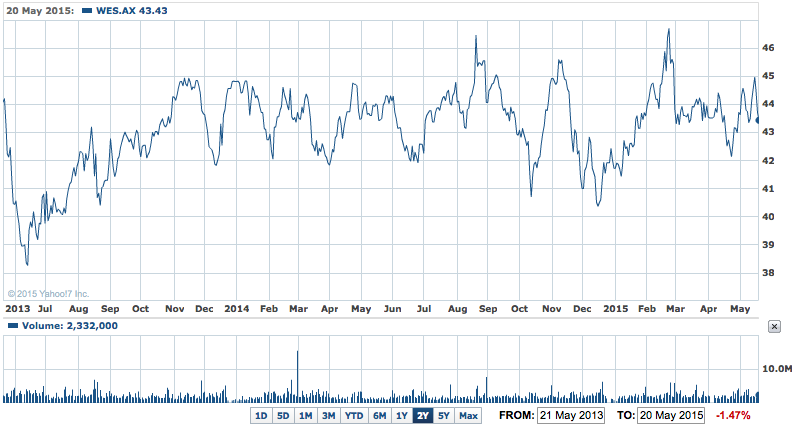Wesfarmers’ (WES) shares fell 0.7% yesterday after the market started digesting a huge strategy package for the next year or so released at the company’s annual investor day.
The shares fell 33c to $43.43 on the update – which ranged from estimates of new investment, new store openings and possible areas of new business for the company’s retail chains.
But from the early reaction from analysts, it’s clear they want Wesfarmers to concentrate more on its retail businesses and less on its under-performing businesses such as coal mining in Queensland and NSW, industrial safety, chemicals and fertilisers.
And that’s the message that Wesfarmers delivered yesterday.
Some analysts wonder why the company continues to invest in the struggling Target chain and why it doesn’t sell the business.
That seems to be why Wesfarmers says it is carving $200 million to $400 million from its investment plans this year, and directing the savings to better performing businesses such as Bunnings and Coles and spending less on businesses struggling to deliver acceptable returns.
Wesfarmers’ finance director Terry Bowen said the company would invest a net figure of between $1.3 billion and $1.5 billion this year, after taking into account about $700 million of property sales.
This compares with Wesfarmers’ previous forecast for 2015 net capex of $1.5 billion to $1.9 billion for 2015.
WES 2Y – Wesfarmers to redirect capex to Bunnings, Coles

Starting the investor day’s proceedings, CEO Richard Goyder addressed the capital allocation question.
He defended the company’s growth record and financial performance and forecast further growth, driven by revenue growth rather than margin gains and potential acquisitions.
"We want to grow profits through sales not by building margins behind the businesses," Mr Goyder told investors and analysts. "We have invested $14 billion since 2009 – through that period our return on capital and return on equity has increased," Mr Goyder said.
Some 80% of that investment had been in Coles and Bunnings.
"Where a business is not generating an acceptable return on capital we are reluctant to invest in growth for those businesses, unless it’s counter cyclical, until we get an adequate return," he said.
"But as we’re very financially disciplined we haven’t found anything that will create value for our shareholders over the long term."
And Wesfarmers said Bunnings will continue to open new stores at a record rate over the next few years and will lift its investment in e-commerce, digital marketing and social media to extend its reach.
Bunnings plans to open between 15 and 18 new warehouse stores in 2016 and 2017, lifting the number to 268 in its network, before reverting to its long-run average of 10 to 14 new warehouses a year.
It also plans to open between two and four smaller-format ‘home centres’ and two trade centres a year for the foreseeable future.
Mr Bowen produced figures in his briefing showing that most of the growth in revenue and earnings in Wesfarmers from 2009 to 2014 has come from the turnaround at Coles and the solid expansion at Bunnings. Revenue is up 4.1% on a compound basis in that time and earnings before interest and tax is up 7.1%.
Meanwhile, Coles managing director John Durkan told the briefing that the chain will move away from discounted promotional pricing to “stable everyday pricing” of its own brands – a move that Woolworths says it is also doing.
Mr Durkan’s outlined what he called a “bold” strategy for expansion, with the retailer (like Woolies), heading for greater use of private labels because of their higher profit margins (but that has also been a recurring ’strategy’ from both retailers down the years to the point where it is all a bit ho-hum).
Mr Durkan said Coles brands were the “middle ground” for everyday Australians and the plan was to launch as many of its own brands across most categories at “everyday pricing”.
As well, like every other major retailer, Coles is aiming to expand its online stores. Mr Durkan said Coles would markedly increase its online presence next year, including its “Click and Collect” service, and another further 50 stand-alone Click and Collect sites will also be opened.
“Online is an important part of a customers’ weekly shopping activity,” he said. “Our customers tell us they want their online shop to be simple and they want their shopping at a time that suits them.”
Mr Durkan said the transformation of Coles’ liquor business was progressing well, with 32 under performing stores closed over the past 12 months and prices reduced on more than 300 Liquorland key liquor lines.













